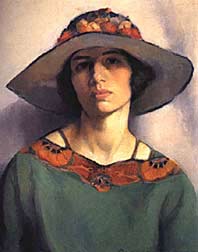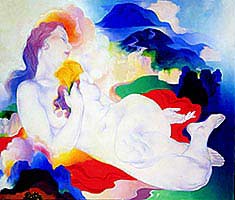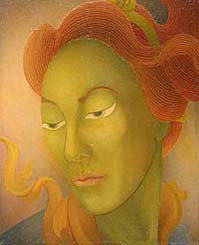The Los Angeles Art Students League
The modernist movement as it grew out of – or was associated with – the Art Students League of Los Angeles (ASL-LA), is the subject of a fascinating exhibition at the Pasadena Museum of California Art – A Seed of Modernism: The Art Students League of Los Angeles, 1906-1953. The exhibit presents over 100 works of art from students and staff of the ASL-LA, which during its time was the third oldest art school in Los Angeles, and a hotbed for the modernist avant-garde until the school closed in the post WWII period.
The original Art Students League was founded in New York in 1875 by artists and students opposed to the stultifying conservatism of New York’s National Academy of Design, and by 1913, the proliferation of modernist ideas in American art lead to the founding of the Art Students League of Los Angeles. Just prior to the establishment of the League, artists trained in Europe’s great schools as well as those who were educated in East Coast academies, were making the trek to California – where they encountered two major dilemmas. Figuration in art was entirely overshadowed by landscape painting and conservative social forces in southern California were in opposition to drawing or painting the nude figure from life, as well as the display of nudes in works of art.
Counteracting this repressive environment, professional painter Hanson Duvall Puthuff (1875-1972), offered studio classes in 1903 where artists (male only at this point in time) could draw from nude models. In 1906 his classes were moved to the Blanchard building at Tenth and Figueroa in L.A., with the school eventually taking the name of the Art Students League of Los Angeles. Later the ASL-LA held its classes in a studio located on Main Street in downtown L.A., finally moving to a studio on Spring Street around 1923.
The forward momentum of Modernism in California not only opened the way for figuration in painting during the 1910s, it was inclusive of women – several of which became leading figure painters in the burgeoning California modernist movement. A number of these pioneering female artists are represented in the show; Helena Dunlap, Loren Barton, Luvena Buchanan Vysekal, and Mabel Alvarez amongst others.

Artist Stanton MacDonald-Wright assumed directorship of the ASL-LA in 1923, a position he would hold for nine years – and a term that represented the flowering of modernism in Los Angeles. While living in Paris from 1912-13, MacDonald-Wright met fellow American painter Morgan Russell (an early exponent of abstraction), and together they originated the movement known as “Synchromism”, which claimed color to be the basis of all form and expression in painting. MacDonald-Wright saw a reflection of his own modernist views in Asian art, which he was extremely interested in, and he encouraged Asian American ASL-LA students like Benji Okubo and Hideo Date (Hid-day-oh Dah-tay) to explore their heritage as a foundation for painting.

MacDonald-Wright stepped down as director of the ASL-LA in 1932, and afterwards a succession of talented artists directed the League, including the painter Lorser Feitelson and Benji Okubo. During this period the color theory ideas of MacDonald-Wright fused with the New Classicism/Post Surrealism of Feitelson and the Japanese art techniques of Okubo. But with world war looming, the experimentalist engine of modernism that was the ASL-LA, was about to fly apart.
At the outbreak of WWII, over 120,000 Japanese Americans in California were rounded up and shipped off to internment camps – which became the fate of Benji Okubo and fellow ASL-LA member, Hideo Date. Along with thousands of other detainees, Okubo and Date were sent to the Santa Anita Race Track in Southern California, where horse stables had been converted into temporary holding cells. From that degrading detention center, the two artists were sent to the Heart Mountain Detention Camp in Wyoming. As you would expect, the incarceration of the ASL-LA director caused havoc with the school, and it eventually disbanded, but not before Okubo and Date launched a branch of the Art Students League at the Heart Mountain detention center.

In the postwar period, painter Fred Sexton, a MacDonald-Wright protégé who had studied with the Art Students League in New York, attempted to revive the League in L.A. He ran the re-opened school from 1949 until 1953 – when it finally closed its doors permanently. I don’t know much about the waning years of the ASL-LA, but I suspect its demise had at least as much to do with the increasing conservatism in the country as it did with the ascendancy and dominance of non-figurative abstract art.
If you are unable to attend the exhibition you can acquire the exhibit catalog, which details the history of the ASL-LA along with the city’s modernist movement. A Seed of Modernism: Art Students League of Los Angeles, at the Pasadena Museum of California Art, in Pasadena, California, from January 20, 2008 until April 13, 2008.


